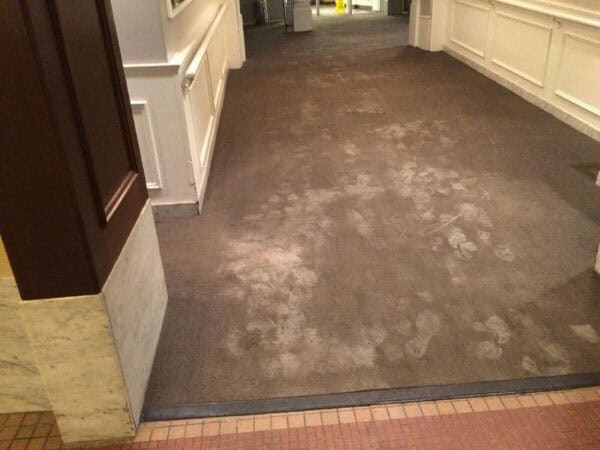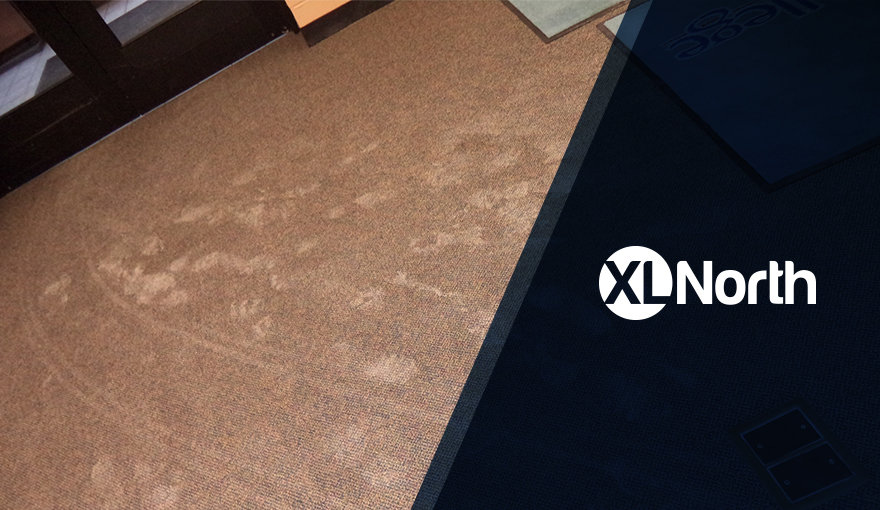Why do Ice & Snow Melt Products cause issues on floors?
Nearly all solid ice & snow melting products on the market today are made from one of (or a blend of) five materials. They are:
- Calcium Chloride
- Sodium Chloride
- Potassium Chloride
- Magnesium Chloride
- Urea
Calcium chloride and sodium chloride (rock salt) are the most popular.

In general, ice & snow melts are very hygroscopic, meaning they draw moisture to them and hold on to it. This property can make the process of removing these products from all flooring types very difficult and can greatly influence a rapid re-soiling problem. Additionally, calcium chloride and magnesium chloride types tend to leave behind an oily residue that increases the difficulty of removal and control problems while being damaging to acrylic based and other finishes. Recent product changes have also included the addition of tints to increase the visual noticeability of displaced ice & snow melt products which can make them more noticeable inside and outside your building. As a result of these multiple factors, ice & snow melt particles and residues can be one of the most challenging problems anyone will encounter in maintaining the appearance and safety of all flooring types.

Here are 5 tips to help stay on top of ice & snow melt problems.
TIP 1: Control the amount of ice & snow melt products being used.
Most of these products are extremely overused due to there being no appropriate training for the application of the products, extreme fears of slip and fall incidents, and because they are often applied rapidly or mechanically. For example, most products are designed to be applied prior to the weather event, not after. If you cannot control the use of the product at your facility, you can at least exert some control over how much enters your building by sweeping or vacuuming overused product from dry flooring and walkways inside & outside your building once they have melted the ice or snow.
TIP 2: Use an abundance of walk off matting inside and outside that can trap snow and ice melt products and moisture.
Strategically selected and placed matting that knocks off the product outside and absorbs moisture inside can be one of the most effective control devices. Most matting manufacturers provide excellent resources to help with the purchase and proper use of these materials. Remember, these mats can be used seasonally and can be swapped out for smaller, more aesthetically pleasing mats in non-winter months.
TIP 3: Extract excess moisture and dry affected areas as quickly as possible.
Use wet vacs, self-contained cleaning machines, or effective mopping systems geared towards specific flooring types, to remove excessive moisture from all types of flooring and dry the floor with air movers, axial fans, or other types of drying equipment. Once dry, the slip/fall liability is greatly reduced, and ice & snow melt products can be swept up or vacuumed efficiently. For carpeted areas, the quality and type of the vacuum used will matter greatly on the effectiveness of it removing these compounds. Commercial model dual vacuum uprights with a roller brush and enclosed bag system are preferred.
TIP 4: Implement a seasonal proactive maintenance plan.
To best remove ice & snow melt compounds you must increase the periodic maintenance frequency for your floors during the winter season. For hard surfaces and resilient flooring, only mopping floors will likely not produce the desired results. Due to the hygroscopic nature of ice & snow melt compounds, most cleaning solutions are rendered less effective by the absorbency of the product being removed. Therefore, the higher amount of rinsing capability and the ability to use vacuuming and squeegee tools makes powered equipment such as wet vacs and self-contained units much more effective and far less time consuming.
TIP 5: Prepare to implement your periodic cleaning procedures for ice & snow melt compound removal beyond winter and into spring.
Due to the high difficulty in removal, migration through buildings and the soil wicking properties of carpet, even with the best procedures in place, ice & snow melt problems may require additional periodic cleaning services for days or months past the last use of the ice & snow melt products outside your building.


